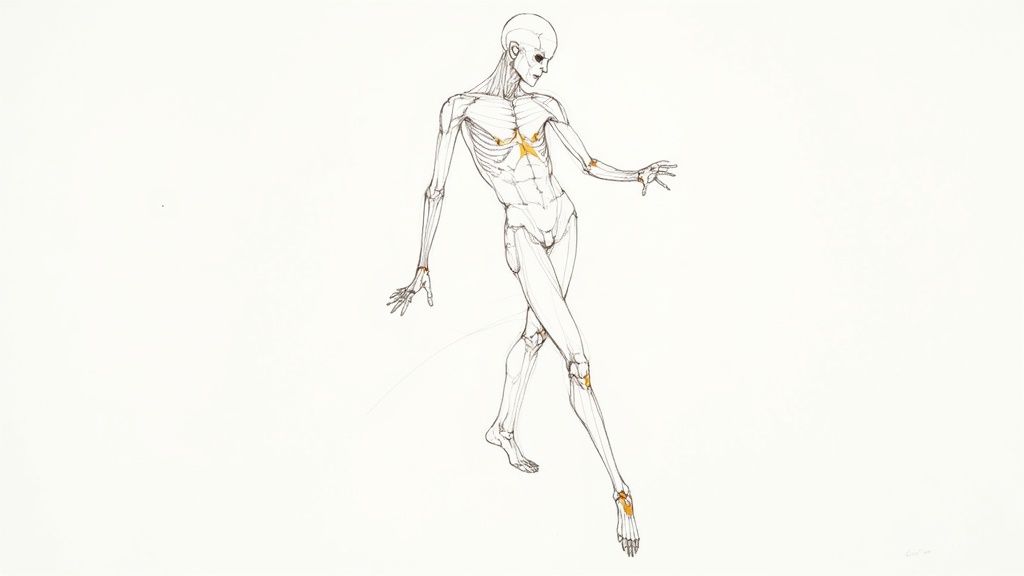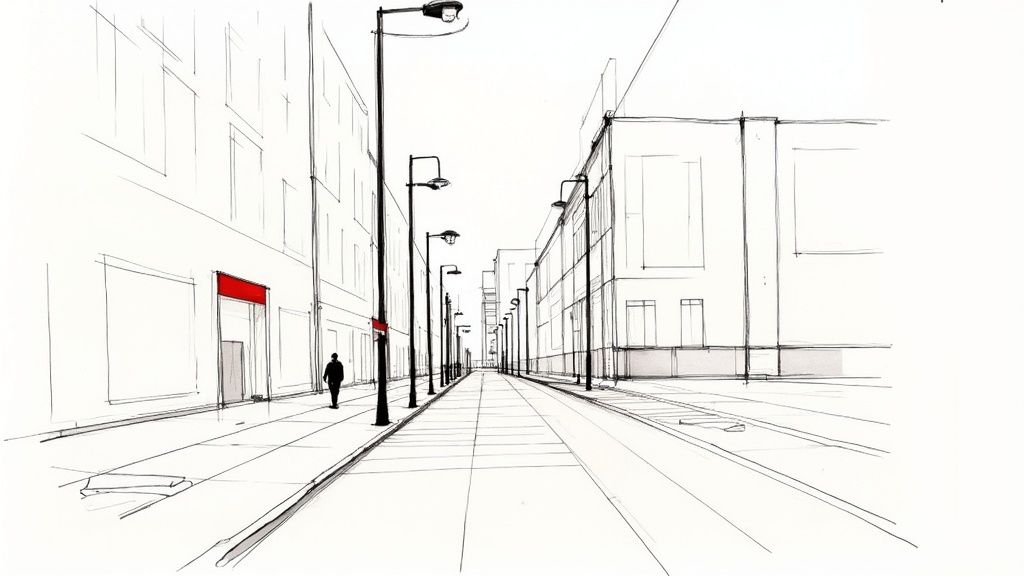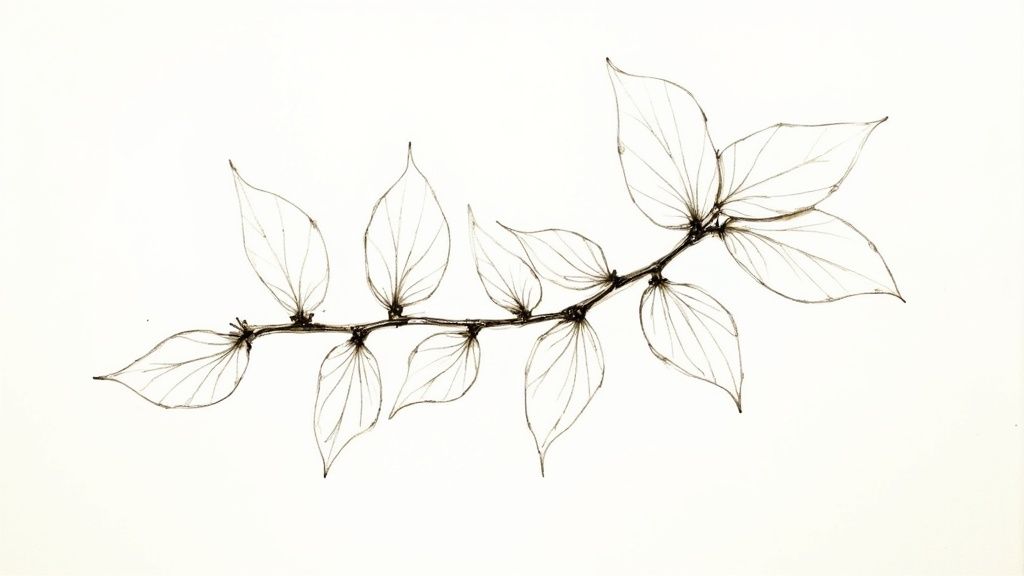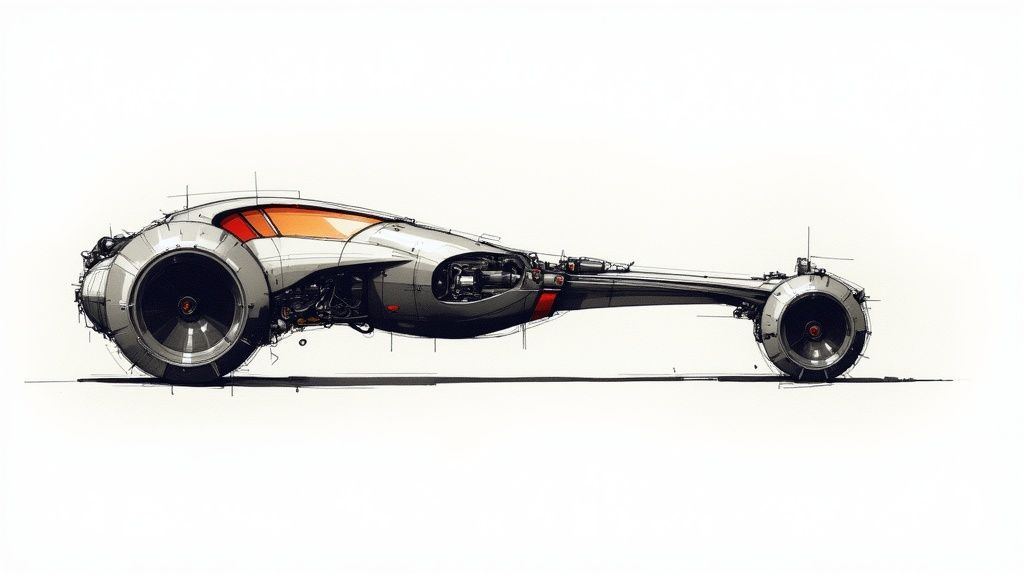Every blank page in a sketchbook holds infinite potential, but sometimes, the biggest challenge is deciding what to draw. Whether you're a seasoned artist seeking new challenges or a beginner looking to build fundamental skills, finding the right sketching art ideas can be the spark that ignites a creative fire. Staring at an empty canvas can be daunting, leading to artist's block, a frustrating hurdle for any creative.
This guide is designed to shatter that block by providing a structured yet inspiring roadmap. We will move beyond generic prompts to offer actionable concepts, practical techniques, and specific exercises across eight powerful categories of sketching. Each section presents a self-contained world of inspiration, from capturing the dynamic energy of the human form in figure drawing to designing imaginative worlds through concept art.
This collection provides a blueprint for deliberate, skill-building, and deeply rewarding artistic practice. Prepare to explore specific, actionable insights in areas like urban sketching, botanical illustration, character studies, and environmental art. This list will help you fill your sketchbook with purposeful drawings that enhance your abilities and fuel your passion, ensuring your next creative session is productive and exciting.
1. Figure Drawing and Human Anatomy
Mastering the human form is a cornerstone of artistic skill, making figure drawing one of the most rewarding sketching art ideas an artist can pursue. This practice involves capturing the essence of the human body, from its underlying muscle and bone structure to the subtle nuances of gesture and expression. It’s a foundational discipline that enhances nearly every other area of drawing, from character design to environmental storytelling.

This timeless practice, championed by Renaissance masters like Leonardo da Vinci and modern educators like Stan Prokopenko, is about more than just rendering a likeness. It's about understanding how the body moves, balances, and conveys emotion. By studying anatomy, you gain the ability to create believable, dynamic figures from imagination.
How to Approach Figure Drawing
To get started, focus on breaking down the body's complexity into manageable parts. This approach helps you build a solid foundation before adding intricate details.
- Start with Gesture: Begin with rapid gesture drawings, lasting anywhere from 30 seconds to two minutes. The goal isn't accuracy but capturing the flow, energy, and rhythm of the pose. This trains your hand and eye to see the overall movement.
- Use Construction: Build your figures using simple shapes like spheres, cylinders, and boxes. This "mannequin" method, popularized by artists like Andrew Loomis, helps establish correct proportions and three-dimensional form.
- Study Anatomy: Dedicate time to studying anatomy from books, online courses, or reference photos. Focus on major muscle groups and skeletal landmarks that influence the surface form. You don't need to be a doctor, just understand what creates the bumps and curves you see.
Pro Tip: Whenever possible, draw from a live model. Working from life provides invaluable information about form, light, and dimension that a photograph cannot replicate.
For artists aiming to create more lively and compelling characters, exploring dynamic poses is the next step. You can delve deeper into this topic by reading our guide to dynamic figure drawing.
2. Urban Sketching and Architecture
Capturing the life and soul of a city on paper, urban sketching is one of the most dynamic sketching art ideas for artists who love their environment. This practice involves drawing on location, documenting the world around you, from grand architectural facades to bustling street corners and quiet cafes. It’s about more than just rendering buildings; it's about telling the story of a place through direct observation.

Popularized by artists like Gabriel Campanario and global communities such as Urban Sketchers, this discipline encourages artists to connect with their surroundings. The practice turns any city outing into an artistic opportunity, blending travel, observation, and drawing into a single, cohesive experience. It trains you to see beauty in the everyday and capture the atmosphere of a moment quickly and expressively.
How to Approach Urban Sketching
Getting started with urban sketching is accessible to all skill levels. The key is to simplify complex scenes and focus on capturing the character of the location.
- Start with Big Shapes: Don't get lost in the details. Begin by blocking in the main shapes of buildings and large structures. This helps establish the composition and proportions before you commit to smaller elements like windows or textures.
- Understand Basic Perspective: A grasp of one-point and two-point perspective is crucial for creating believable cityscapes. Start with simple one-point perspective to draw a street scene, establishing a horizon line and a single vanishing point.
- Focus on Essence, Not Perfection: The goal is not a photorealistic copy but a personal interpretation of the scene. Capture the energy, light, and general feel. It’s okay if lines are wobbly or details are simplified; that’s part of the charm.
Pro Tip: Keep your sketching kit minimal and portable. A small sketchbook, a few pens, and a compact watercolor set are all you need. This makes it easy to stop and sketch whenever inspiration strikes.
This approach is an excellent way to build confidence in drawing from life. For a deeper dive into techniques, you can discover more about urban sketching on Drawinglist.com.
3. Nature and Botanical Illustration
Capturing the intricate beauty of the natural world is one of the most serene and rewarding sketching art ideas for artists of all levels. Botanical illustration merges artistic expression with scientific observation, focusing on the detailed depiction of plants, flowers, and other natural elements. This discipline sharpens your observational skills while fostering a deeper connection to the environment.

This classic art form, practiced by historical figures like Maria Sibylla Merian and Pierre-Joseph Redouté, is more than just drawing pretty flowers. It’s about understanding plant structure, growth patterns, and the subtle textures that define each species. By studying botanical subjects, you learn to see with precision and translate that vision into elegant, accurate drawings.
How to Approach Botanical Illustration
To begin your journey into botanical drawing, focus on careful observation and building your drawings layer by layer. This methodical approach is key to capturing the delicate details of your subjects.
- Start with Simple Forms: Begin by sketching basic leaf and flower shapes. Observe how petals radiate from a central point or how leaves connect to a stem. This helps you understand the fundamental construction of plants.
- Study Plant Structure: Look closely at the subject's anatomy. Identify the arrangement of petals (whorled, spiral), the type of leaf venation, and how the plant grows. This foundational knowledge makes your drawings more believable.
- Use Light Construction Lines: Sketch your initial shapes very lightly. This allows you to establish placement and proportions without committing to hard outlines, making it easier to refine details and add shading later.
- Practice Shading: Focus on rendering form through value. Use techniques like cross-hatching or stippling to create shadows that reveal the three-dimensional shape of petals, stems, and leaves.
Pro Tip: Keep a dedicated nature journal. Regularly sketching plants you find on walks or in your garden builds a visual library and makes observation a consistent habit.
For those eager to cultivate their skills in this area, you can find more inspiration by exploring our detailed guide on botanical illustration.
4. Portraiture and Character Studies
Drawing faces is a deeply human and compelling artistic endeavor, making portraiture one of the most classic sketching art ideas for artists of all levels. This practice focuses on capturing likeness, personality, and emotion through the careful study of facial features and expressions. It spans from creating realistic portraits to developing stylized character designs for animation, comics, or games.

This discipline, honored by masters like John Singer Sargent and reinvented by contemporary artists like Kim Jung Gi, is about more than just drawing a face. It is an exploration of identity and storytelling. Whether for a formal commission or a quick character study, understanding how to construct a face is a powerful skill that brings your artwork to life.
How to Approach Portraiture
Success in portraiture comes from balancing structural knowledge with observational skills. A methodical approach ensures your portraits have both accuracy and soul.
- Master Facial Proportions: Start by learning the basic proportions of the head using methods like the Loomis method. Understand where the eyes, nose, and mouth are generally placed. This framework provides a reliable starting point for every face you draw.
- Capture the Overall Impression First: Before diving into details like eyelashes or wrinkles, focus on the big shapes of light and shadow. Squinting your eyes can help you see these value masses more clearly and establish a strong likeness early on.
- Practice from Multiple Angles: A face is a three-dimensional form. Practice drawing heads from above, below, and in three-quarter view to understand how features change with perspective. Use reference photos or a mirror for self-portraits to explore different angles.
Pro Tip: Don't just copy what you see; interpret it. Pay close attention to the features that define a person's character, such as the shape of their eyes or the set of their mouth, and slightly emphasize them to inject more personality into your sketch.
5. Still Life and Object Studies
The tradition of still life drawing offers a powerful way to hone fundamental artistic skills, making it one of the most accessible and effective sketching art ideas for artists at any level. This practice involves sketching inanimate objects, from simple household items to elaborate arrangements, to study form, light, shadow, texture, and composition. It is a foundational exercise that builds technical precision and a deep understanding of how to render the world in two dimensions.
This timeless practice, a staple in art academies and a subject masterfully explored by artists like Jean-Baptiste-Siméon Chardin and Giorgio Morandi, is about seeing the extraordinary in the ordinary. By carefully observing and rendering everyday objects, you train your eye to perceive subtle value shifts, reflective properties, and the interplay of forms. This disciplined observation is crucial for creating convincing and realistic artwork.
How to Approach Still Life
To get started with still life, begin by controlling your environment and gradually increasing complexity. This methodical approach ensures you build skills on a solid foundation of observation and rendering.
- Start with Simple Forms: Begin with single, geometrically simple objects like an egg, a cube, or a sphere. This allows you to focus purely on capturing form and how light describes it without the distraction of complex textures or details.
- Control Your Lighting: Use a single, strong light source, such as a desk lamp, to create clear and defined shadows. This makes it easier to understand and depict the planes of an object and its cast shadow, which helps create a sense of three-dimensional space.
- Build Thoughtful Compositions: As you get more comfortable, arrange several objects together. Think about varying their size, shape, and texture to create visual interest. A good composition will guide the viewer's eye through the drawing.
Pro Tip: Don't limit yourself to just pencil. Experiment with different media like charcoal, ink, or conte crayon. Each medium will force you to interpret textures and values in a new way, broadening your artistic vocabulary.
For artists who want to master rendering different surface properties, still life is the perfect training ground. You can explore this further by studying the techniques in Charles Bargue's drawing course, a classic resource for realistic drawing.
6. Concept Art and Imagination Drawing
Venturing into concept art is one of the most exciting sketching art ideas for artists who love to build worlds from scratch. This discipline involves creating the visual designs for characters, environments, creatures, and props that form the foundation of video games, films, and animation. It's the art of turning a written idea into a tangible, visual blueprint.
Pioneered by visionaries like Syd Mead and Ralph McQuarrie for franchises such as Blade Runner and Star Wars, concept art blends imagination with the practical application of art fundamentals. The goal is to create designs that are not only visually stunning but also functional and believable within the context of their fictional universe. Drawing from imagination is a skill that strengthens your creative problem-solving abilities.
How to Approach Concept Art
To begin creating your own worlds, focus on a structured process that moves from broad ideas to refined designs. This approach ensures your concepts are well-thought-out and visually coherent.
- Build a Visual Library: Actively study the world around you and analyze existing designs. Understand why a certain character design is memorable or how an environment tells a story. Collect references for textures, shapes, and lighting to fuel your imagination.
- Practice Rapid Ideation: Start with quick thumbnail sketches to explore as many different ideas as possible without committing to one. This brainstorming phase is crucial for discovering unique shapes and compelling compositions before investing time in a polished rendering.
- Ground Fantasy in Reality: The most believable fictional designs are rooted in real-world principles. Apply your knowledge of anatomy, perspective, and lighting to make your fantastical creatures or futuristic cities feel plausible and grounded.
Pro Tip: Your portfolio should tell a story. Instead of isolated drawings, create project-based pieces, like designing three characters from the same faction or multiple environments from a single world, to showcase your world-building skills.
For those looking to build a career in this field, platforms like ArtStation are invaluable resources for studying the work of professional concept artists and understanding industry standards.
7. Gesture and Movement Studies
Capturing the essence of life and energy is a fundamental challenge in art, and gesture drawing is one of the most powerful sketching art ideas for mastering it. This practice involves creating rapid, expressive drawings that prioritize the flow, rhythm, and movement of a subject over precise details. It's the art of conveying action and emotion in just a few dynamic strokes.
This method, championed by animation legends like Walt Stanchfield and life drawing instructors like Glenn Vilppu, trains your brain to see beyond static outlines and identify the core energy of a pose. It's the foundational skill behind every dynamic character in animation and every compelling figure in illustration, teaching you to communicate a story through the body's language.
How to Approach Gesture and Movement Studies
To begin, the key is to let go of perfection and embrace speed. The goal is to internalize the feeling of movement and translate it onto the page instinctively.
- Find the Line of Action: Before drawing anything else, identify the primary curve or line that runs through the subject's pose. This "line of action" is the backbone of your sketch and dictates the overall flow.
- Use Your Whole Arm: Avoid drawing with just your wrist. Use your shoulder and elbow to make long, confident, and continuous strokes. This creates more fluid and energetic lines.
- Embrace Timed Sessions: Set a timer for 30 seconds, one minute, or two minutes per pose. This forces you to focus only on the essential information, preventing you from getting bogged down in unnecessary details.
- Focus on Rhythm, Not Anatomy: During gesture drawing, ignore individual muscles or facial features. Instead, concentrate on the relationships between forms, the weight distribution, and the overall rhythm of the pose.
Pro Tip: Use reference from subjects that are naturally in motion. Watching videos of athletes, dancers, or animals and pausing them at key moments provides an endless supply of dynamic poses to study.
For artists wanting to bring their characters and scenes to life, mastering gesture is non-negotiable. It is the bridge between a stiff, lifeless drawing and one that feels vibrant and believable. Regular practice builds a visual library of movement that you can later pull from when drawing from imagination.
8. Landscape and Environmental Art
Capturing the majesty of the world around us makes landscape and environmental art one of the most timeless sketching art ideas available to an artist. This discipline involves drawing natural and constructed environments, from sprawling mountain ranges and dense forests to serene seascapes and quiet rural scenes. It’s a practice that teaches you to observe and interpret the complex relationships between light, form, and atmosphere.
This tradition, carried from the grand canvases of the Hudson River School painters like Thomas Cole to the modern plein air sketching movement, is about more than just copying a pretty view. It’s an exercise in understanding composition, perspective, and how to convey a sense of place and mood. Mastering it allows you to build convincing worlds for your stories or simply document the beauty of your surroundings.
How to Approach Landscape and Environmental Art
To avoid feeling overwhelmed by nature's complexity, it's best to simplify the scene into its core components before adding texture and detail.
- Simplify Compositions: Start by identifying the major shapes in your scene: the sky, the ground, and the large elements like trees or buildings. Use simple thumbnail sketches to test different arrangements before committing to a final drawing.
- Apply Atmospheric Perspective: Create a sense of depth by making objects in the distance lighter, less detailed, and cooler in color. Objects in the foreground should have stronger contrast, sharper details, and warmer tones. This single principle dramatically enhances realism.
- Study the Sky and Light: The time of day and weather conditions dictate the entire mood of a landscape. Practice sketching cloud formations and pay close attention to how light and shadow change during a "golden hour" sunrise or the harsh midday sun.
Pro Tip: When sketching outdoors (en plein air), pack light but smart. A small sketchbook, a few pencils or pens, and a portable stool are often all you need. Focus on capturing the feeling of the moment rather than a perfect rendition.
8-Topic Sketching Art Comparison
Drawing Type | Implementation Complexity | Resource Requirements | Expected Outcomes | Ideal Use Cases | Key Advantages |
|---|---|---|---|---|---|
Figure Drawing and Human Anatomy | Intermediate to Advanced | Access to live models, anatomy books | Accurate human form, improved observation | Animation, illustration, fine art | Essential foundation, enhances form understanding |
Urban Sketching and Architecture | Moderate | Portable kit, access to locations | Improved perspective, location journals | Travel, city documentation, architecture students | Minimal equipment, encourages exploration |
Nature and Botanical Illustration | Moderate to Advanced | Botanical references, outdoor access | Scientific accuracy, detailed plant studies | Scientific documentation, nature journaling | Develops patience, educational value |
Portraiture and Character Studies | Intermediate to Advanced | Reference photos, lighting setups | Capturing likeness and emotion | Portrait art, character design | Highly valued skill, versatile application |
Still Life and Object Studies | Beginner to Intermediate | Inanimate objects, controlled lighting | Strong fundamental drawing skills | Art education, practice of form and light | Full control over subject, systematic skill development |
Concept Art and Imagination Drawing | Advanced | Research materials, digital tools | Creative visual designs, storytelling | Games, films, publishing | Creative freedom, strong career potential |
Gesture and Movement Studies | Beginner to Intermediate | Minimal (paper, pencil) | Quick capture of motion and energy | Animation prep, warm-up exercises | Builds spontaneity, enhances dynamic drawing |
Landscape and Environmental Art | Moderate | Outdoor access, weather-dependent | Atmospheric depth, compositional skills | Nature scenes, plein air sketching | Connects with nature, improves composition |
From Ideas to Action: Making Sketching a Daily Habit
We've explored a diverse landscape of creative territories, from the intricate lines of urban architecture to the expressive forms of the human figure. Each of the eight domains covered in this guide, including still life, portraiture, and imaginative concept art, offers more than just a simple prompt. They represent entire universes of visual language, complete with their own rules, challenges, and immense rewards. These sketching art ideas are your starting points, your gateways to seeing the world not just as it is, but as it could be through your unique artistic lens.
The journey from inspiration to skill, however, is paved with consistent practice. An idea remains just an idea until a pencil meets paper. The true engine of artistic growth is the establishment of a creative habit, transforming a fleeting desire to draw into a sustained, rewarding practice. This is where the real work, and the real magic, begins.
Turning Inspiration into Actionable Practice
The key is to move beyond simply collecting ideas and start implementing them. Don't let the sheer number of possibilities lead to paralysis. Instead, focus your efforts to build momentum.
- Commit to One Theme: Select one of the categories that resonated with you the most. Did the idea of capturing the soul of a city in your sketchbook excite you? Dedicate the next week exclusively to urban sketching. Were you drawn to the challenge of creating characters from your imagination? Spend your daily drawing time on concept art and character studies.
- Set a Time and Place: Integrate sketching into your daily routine. This could be 15 minutes of gesture drawing with your morning coffee, a lunchtime still life study of your desk items, or an hour of landscape sketching at a local park on the weekend. A consistent schedule removes the friction of deciding when and where to draw.
- Embrace Imperfection: Your sketchbook is a laboratory, not a gallery. It is a space for failed experiments, happy accidents, and raw, unfiltered practice. The goal is not to create a masterpiece with every sketch but to learn something new with every line you draw. Let go of the pressure to be perfect and give yourself the freedom to simply create.
By focusing on one area at a time and committing to a regular schedule, you build a powerful feedback loop. Each sketch informs the next, gradually strengthening your observation skills, refining your technique, and building your creative confidence. These foundational practices are what separate passive dreamers from active creators.
Ready to eliminate creative block for good and find the perfect prompt every time? Explore Drawing List, our AI-powered platform designed to provide you with an endless supply of unique sketching art ideas tailored to your interests and skill level. Visit the Drawing List website to generate your next great idea and keep your creative momentum going strong.